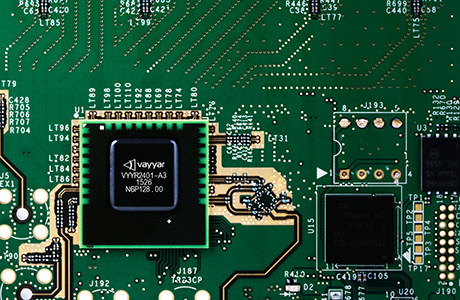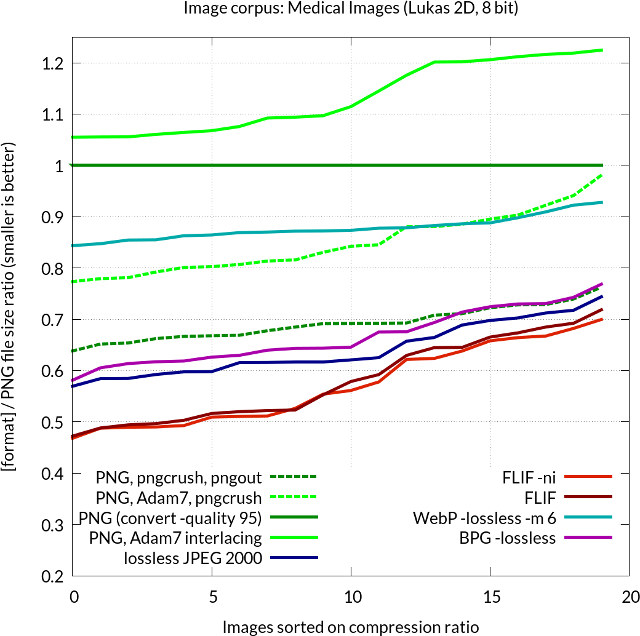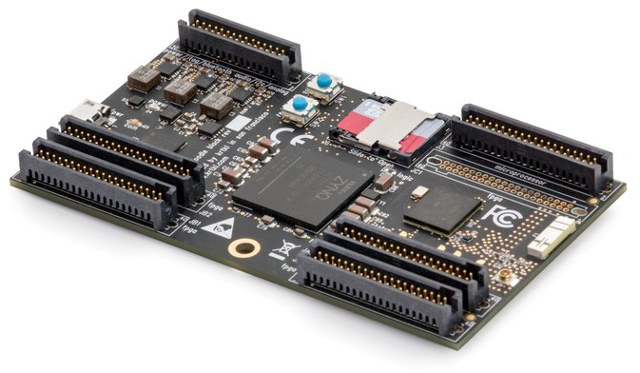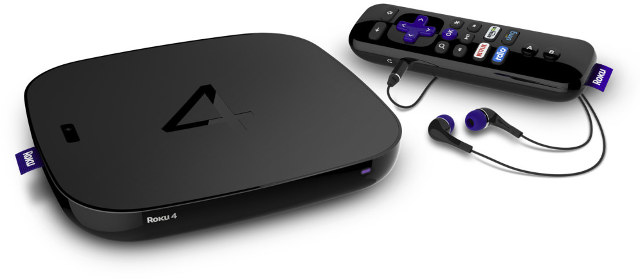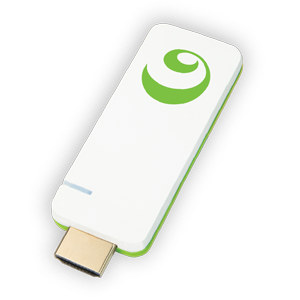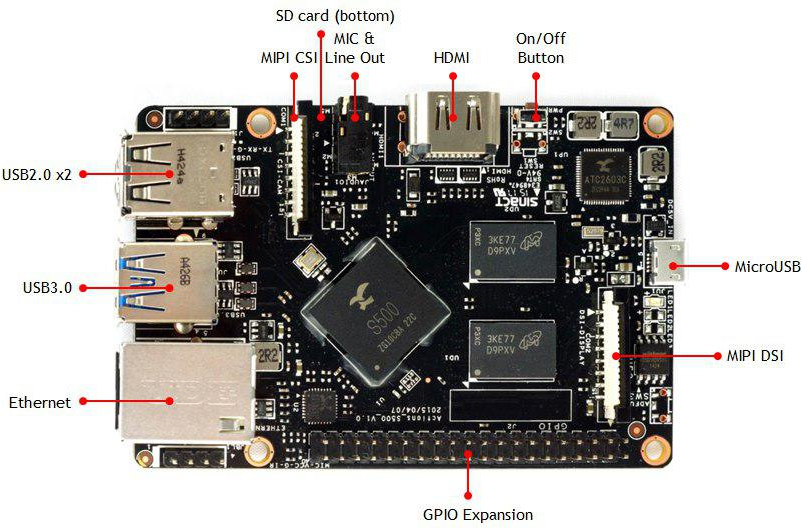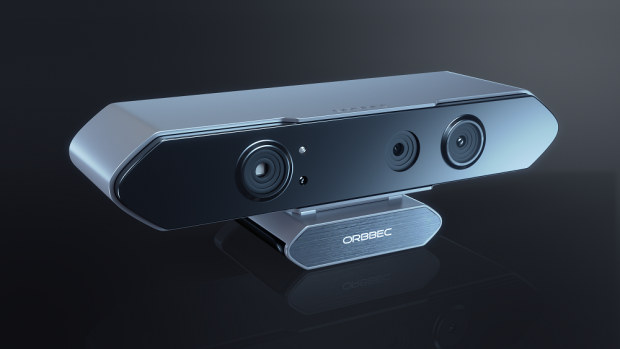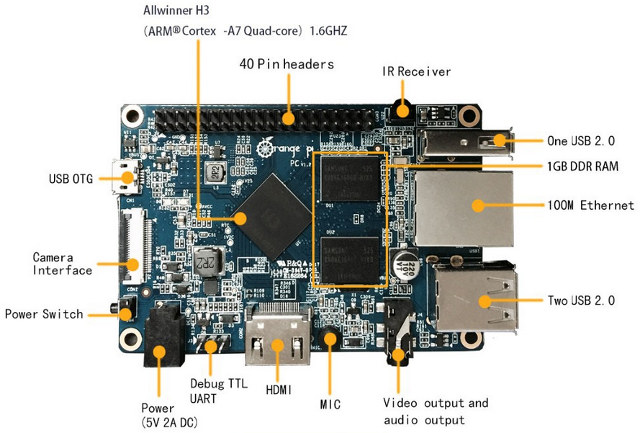A few days ago, I wrote about Orbbec Astra 3D camera that can analyze distance and depth to form a 3D image of object. However, this solution uses an IR sensors, and while it can fulfill the needs of many application it does not allow to see through object, and that’s exactly what Walabot wideband MIMO radar board promises to do thanks to Vayyar 3D imaging sensor and a dozen of RF antennas. Some of the key features and preliminary specifications of Walabot board include: Vayyar VYYR2401 3D imaging sensor 12 (or is it 14?) non-contact antennas array system based on “Octopus A3 System on chip” Build in Tx/Rx linear polarized wide-band antennas from 3-10Ghz. On-board Cypress FX3 controller for communication and pre-processing EEPROM (for inventory and calibration information) Walabot interface connectors: Micro-USB 2.0 for high-rate data communication. Option to provide supply from USB. Single supply voltage 4.5-5.5v input for […]
FLIF Lossless Image Format Claims to Outperform PNG, JPEG2000, WebP, and BPG
FLIF, which stands for Free Lossless Image Format, is a new lossless image format that is said to provide better compression ration than PNG, lossless JPEG2000, lossless WebP, and lossless BPG for all king of images including medical images, geographical maps, cliparts and so on. Beside being lossless, FLIF is also progressive, so a lower quality version of the image can be displayed early while the download is still in progress. The developer has uploaded a video comparing how a PNG image and FLIF image would load in a slow network. Other FLIF features include: Lossless compression Greyscale, RGB, RGBA Up to 16 bits color depth per channel (high dynamic range) Interlaced (default) or non-interlaced Animation support “Encoding and decoding speeds are not blazingly fast, but they are in the right ballpark” Based on MANIAC (Meta-Adaptive Near-zero Integer Arithmetic Coding) algorithm developed by Jon Sneyers and Pieter Wuille. (However details […]
Snickerdoodle Xilinx Zynq ARM + FPGA Board Starts at $55 (Crowdfunding)
While Xilinx Zynq UltraScale+ ARMv8 + FPGA SoC is still in development, there are already quite a few Xilinx Zynq-7000 boards on the market today. The cheapest I know of is MYirTech Z-Turn board selling for $99, but krtkl (pronounced “critical“), US a based startup, will soon bring an even cheaper Zynq-7010/7020 board with their Snickerdoodle board currently listed on CrowdSupply platform for $55 and up, plus shipping. Snickerdoodle board specifications: SoC Xilinx Zynq-7010 dual core Cortex A9 processor @ 667 MHz + FPGA with 430K gates or Xilinx Zynq-7020 dual core Cortex A9 processor @ 866 MHz + FPGA with 1.3million gates (~430K ASIC gates) System Memory – 512MB or 1GB LPDDR2-800 Storage – micro SD card slot, 16MB boot flash Connectivity via Ti Wilink 8 solution 2.4GHz 802.11 b/g/n WiFi + Bluetooth 4.0 or Dual band 802.11 b/g/n WiFi (2×2 MIMO) + Bluetooth 4.0 USB – 1x micro USB port […]
Roku 4 Media Player Supports H.265 and VP9 4K Videos, 7.1 Channel Audio Pass-through
Roku has announced the latest version of their video streaming player. Roku 4 comes with a faster quad core processor, supports H.265 & VP9 video playback up to respectively 2160p60 and 2160p30, and includes a new version of Roku operating systems. Roku 4 specifications: SoC – Unnamed Quad core ARM processor with OpenGL ES 2.0 capable GPU System Memory – 1.5GB RAM Storage – TBD internal storage – micro SD slot Video Output – HDMI 2.0 up to 3840×2160 @ 60Hz with HDCP 2.2 support Audio Output – HDMI or optical S/PDIF with support for Dolby Digital Plus 7.1 surround pass-through Video Codecs – 4K UHD 60 fps HEVC Playback, 4K UHD 30 fps VP9 Playback (YouTube) Connectivity – 802.11ac MIMO dual-band wireless, 10/100 Base-T Ethernet USB – USB host port Power supply – 12V/1A Power consumption – 12.4W (typ.) when streaming 4K UHD video Dimensions – About 16.5 x […]
Kinoma HD is $25 TV Stick Devkit Based on Marvell ARMADA 1500 Mini Plus Processor
Marvell has just revealed that ChromeCast 2.0 & Audio featured their ARMADA 1500 Mini Plus (88DE3006) processor with two ARM Cortex A7 cores, coupled with 512 MB RAM, and Avastar 88W8887 wireless solution with WiFi 802.11 b/g/n/ac, Bluetooth 4.1, NFC and FM radio. But a comment on Anandtech lead me to a development kit based on 88DE3006 I missed while I was away: Kinoma HD. Preliminary hardware specifications: SoC – Marvell ARMADA 1500 Mini Plus (88DE3006) dual core Cortex A7 @ 1.2 GHz with 3D GPU supporting OpenGL ES 1.1/2.0, Qdeo video engine System Memory – 256 MB RAM Storage – TBD Video Output – HDMI output of 1080p/720p Connectivity – Wi-Fi g/n/ac Power Supply – 5V via micro USB port Apart for the lower memory capacity (256MB vs 512MB), Kinoma HD hardware looks pretty similar to ChromeCast 2.0. But the main difference is in the software, as while ChromeCast […]
Roseapple Pi Board Powered by Actions Semi S500 Comes with 2GB RAM
[Update: I’ve finally received an answer: Lemon Pi and RoseapplePi makers are different companies, but they just happen to both use the same Actions Semi S500 reference design, and RoseapplePi is manufactured in Taiwan. The picture above is V1.0 board, but V1.1 will have some modifications] Lemon Pi development board was launched this May via a Indiegogo campaign. The board, based Actions Semi S500 quad core Cortex A9 processor, got fully funded by over 200 backers, but at the time of launch, some people questioned the used of the word “Lemon” in a product name, as it has several pejorative meanings, including “something that is useless or crappy”. I was contacted about a new Roseapple Pi board yesterday, and upon checking out the details, it looks exactly like the Lemon Pi, except it got upgraded to 2GB RAM, just like in Indiegogo… The board name on the PCB also reads […]
Orbbec Persee Android & Ubuntu Mini PC Comes with a 3D Camera and SDK (Crowdfunding)
Orbbec is a startup working on 3D cameras which can be used for gesture recognition, 3D scanning, research purpose, and more. The company has now embedded their Astra 3D sensor into an ARM based mini PC running Android and/or Ubuntu which they call Orbbec Persee. Persee hardware specifications: SoC – Quad core Cortex A17 processor up to 1.8GHz with a Mali-T7xx GPU @ 600 MHz (They did not name it, but it must be Rockchip RK3288) System Memory – 2GB DDR3 Storage – 16GB eMMC flash, 1x micro SD card slot up to 64GB Video & Audio Output – HDMI 2.0 Audio Input – 2x microphones Camera – Built-in Astra Pro 3D camera RGB image size – 1280×720 @ 30 fps (UVC support) Depth image size – 640×480 @ 30 fps (16-bit) Range – 0.4 to 8 meters Depth accuracy – 0.5 centimeters at 2 meters Field of view – […]
Orange Pi PC Not Booting? You Are Not Alone…
Orange Pi PC development board launched at the end of August, and quickly went viral thanks to low $15 price tag. The company, Shenzhen Xunlong Software, is fairly small, with just over 10 employees, so when they started getting several thousands customers in a short time, they may have been overwhelmed, and this likely resulted in delays with regards to shipping, and acceptance into Orange Pi forums. Several people have now received their boards, and while many found it to work fine, I’ve been informed several people apparently got a non booting device. People on Youtube and Orange Pi Forums also complained about a booting issue until Ethernet lights up, or Ethernet not working, while other reports Linux is working, but not Android. Unless there was a bad batch during manufacturing, it’s hopefully mostly a firmware issue. The person who reports Ethernet not working, first used the images from Orange […]


